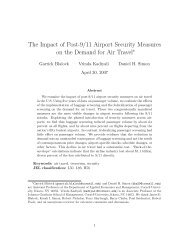Writing a Business Plan: A Guide for Small Premium Wineries
Writing a Business Plan: A Guide for Small Premium Wineries
Writing a Business Plan: A Guide for Small Premium Wineries
You also want an ePaper? Increase the reach of your titles
YUMPU automatically turns print PDFs into web optimized ePapers that Google loves.
Financial Statements<br />
The balance sheet, income statement, and statement of cash flows are three<br />
financial statements used in financial analysis. A further description of each of these<br />
financial statements follows.<br />
The balance sheet shows the value of the items owned (assets), all claims against<br />
the business (liabilities), and the resulting difference is net worth or owner’s equity.<br />
Assets- Liabilities= Net Worth or Owner’s Equity. The balance sheet is a “snapshot” of<br />
the business financial position at any one point in time, usually at the end of the fiscal<br />
year (<strong>for</strong> most businesses, December 31). Assets are simply those items that the business<br />
owns. Assets are broken down into two classes: current and non-current assets. Current<br />
assets are cash and other assets that can be converted into cash through “normal”<br />
operation of the business during the year. Non-current assets “can be liquidated”, but<br />
generally would require more time to attain a fair price and sale would drastically alter<br />
the business’ ability to operate. Assets can be valued according to their current market<br />
value or according to their cost, or “book” value. Many balance sheets list both values.<br />
The cost value reflects the undepreciated balance of assets while market value reflects the<br />
value of assets according to current market conditions.<br />
Liabilities are what you owe, and are divided into current and non-current<br />
liabilities. Current liabilities are those obligations that need to be repaid within one year.<br />
Non-current liabilities are obligations that have repayment schedules in excess of one<br />
year.<br />
The income statement is a “flow concept” that determines the business’<br />
profitability over a given time period. Net income is used to evaluate the business’<br />
profitability and it is calculated by subtracting the firm’s expenses from the revenues.<br />
Revenues are the money the firm makes and expenses are the costs it incurs in the<br />
process of earning revenue. Income statements may be either be accrual based or cash<br />
based. Cash based income statements are the simplest of the two. With cash based<br />
accounting, revenue is considered earned when cash is received and expenses are<br />
considered incurred when cash is paid. Accrual accounting is preferred to cash based<br />
accounting because it most accurately reflects what is happening to the business. Under<br />
accrual accounting, revenue is considered earned in the period the revenue transaction<br />
takes place, and expenses are considered incurred when goods or services are used or<br />
consumed. Thus in addition to cash receipts and expenses, accrual accounting also<br />
considers changes in accounts receivable, accounts payable and inventories of product,<br />
input, supplies, etc.<br />
The statement of cash flows is a summary of the cash inflows and outflows of the<br />
business over a given time period. The statement of cash flows addresses the issue of<br />
whether the business can meet its financial obligations. It examines the amount of cash<br />
available to the business and shows how this cash was used. Only cash transactions are<br />
recorded on the statement of cash flows. The in<strong>for</strong>mation comes from the projected<br />
income statement. Of course, projections are easier to make if the business plan<br />
represents an on-going business. Start up businesses will have to rely on available<br />
published studies and hypothetical projections.<br />
22



